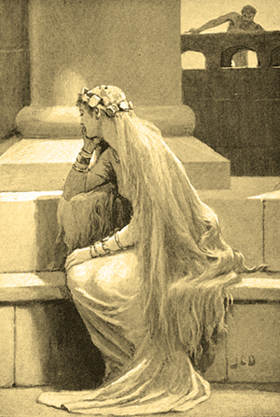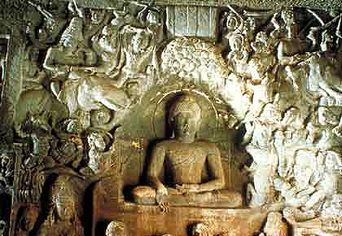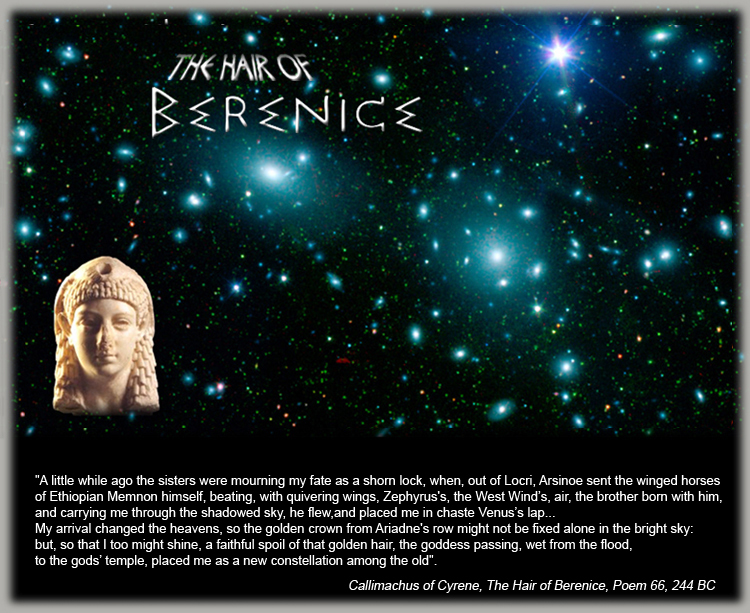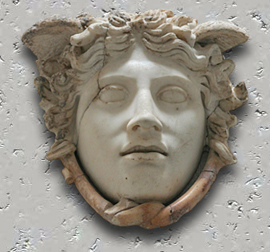
THE CONSTELLATION OF BERENICE'S HAIR
The Seleucid queen Berenice II of Egypt, wife of the king Ptolemy III Euergetes, belonged to the Ptolemaic dynasty. Ptolemaics were not Egyptians, but of Macedonian origin, -Greeks-, of Helenistic culture. They ruled Egypt along three centuries and their last queen was Cleopatra. In the year 243 BC, Berenice sacrificed her long hair to the goddess Aphrodite, asking her for her husband returned safely and successful from his war against Syria. He could do it, but Berenice's hair, which was left at the temple, was stolen by a priest, upset because the offering was made to a Greek deity. Konon, the court astronomer, was called to fix the incident, and he announced that Aphrodite had accepted the offering with pleasure and she placed the hair in the sky, forming a cluster of stars that now shines in the Galactic North Pole.
The constellation Coma Berenices is located close to the constellation Leo and it's more visible in May. Berenices is an isosceles triangle shaped by its 3 more brilliant stars: β Comae Berenices, α Comae Berenices (also called "Diadem", symbolizing the gem in the queen's crown) and γ Comae Berenices.
 "And thence for Sif new tresses I'll bring of gold, ere the daylight's gone...So that she shall liken a field in spring, with its yellow-flowered garment on ..." The Dwarfs, Oehlenschläger.
"And thence for Sif new tresses I'll bring of gold, ere the daylight's gone...So that she shall liken a field in spring, with its yellow-flowered garment on ..." The Dwarfs, Oehlenschläger.
In the norse mythology, common to Scandinavians, Germans and Saxons, Sif was the wife of Thor, the thunder god. She had a beautiful long hair, that fell past her feet, and it color was like the wheat fields gleaming in the sunlight. Some day while she was sleeping, the trickster god Loki, god of thieves and adventurers, cut it off, running away with the hair. While she was crying out in anger, her husband Thor stormed, threatening with the worst punishments to the author of that incident. Loki, fearing the vengeance of Thor, traveled to Asgard and to Smifhelm, home of the dwarves, for help. They weaved threads of golden hair longer than before, with its locks wrought out of authentic precious gold. Loki came back at the next day with the new hair and the gods' fury was appeased.
 Samson was a Judge of the ancient Israelites, a character of the Hebrew Talmud, the Jewish Bible, who had the characteristics of a Greek Hercules. His story is narrated in the Christian Bible in Book of Judges, 13-16. An angel appears to Manoah and his wife in the moment in which the Hebrews were oppressed by other people, the Philistines, promising them that their un-birth son will get rid them of the Philistines, if he accomplished with the Nazirite Oath, which consists in, amongst other stipulations, not to shave or cut his hair. Samson grows up with this sacred oath and he acquires an extraordinary force to make great heroic deeds, like to defeat a lion and to kill a thousand of Philistines with only the jawbone of an ass. In one moment of his life, he falls in love with a woman, Delilah, who is bribed by the Philistines in order that she discovers the secret of his strength. After many unsuccessful attempts, Delilah discovers for the own confession of Samson that his secret resides in the length of his hair. Then, she, while Samson sleeps, cut his hair and delivers it to the Philistines, who enslaves him and make him blind stabbing out his eyes with their swords. Nevertheless, Samson recovers his long hair and his strength, and in a moment in which all the Philistines were assembled in their temple, with the help of God, he leans against two pillars, pulling them and destroying the whole temple, killing all the Philistines, while saying “Lord, let me die with the Philistines!" (Judges, 16:30).
Samson was a Judge of the ancient Israelites, a character of the Hebrew Talmud, the Jewish Bible, who had the characteristics of a Greek Hercules. His story is narrated in the Christian Bible in Book of Judges, 13-16. An angel appears to Manoah and his wife in the moment in which the Hebrews were oppressed by other people, the Philistines, promising them that their un-birth son will get rid them of the Philistines, if he accomplished with the Nazirite Oath, which consists in, amongst other stipulations, not to shave or cut his hair. Samson grows up with this sacred oath and he acquires an extraordinary force to make great heroic deeds, like to defeat a lion and to kill a thousand of Philistines with only the jawbone of an ass. In one moment of his life, he falls in love with a woman, Delilah, who is bribed by the Philistines in order that she discovers the secret of his strength. After many unsuccessful attempts, Delilah discovers for the own confession of Samson that his secret resides in the length of his hair. Then, she, while Samson sleeps, cut his hair and delivers it to the Philistines, who enslaves him and make him blind stabbing out his eyes with their swords. Nevertheless, Samson recovers his long hair and his strength, and in a moment in which all the Philistines were assembled in their temple, with the help of God, he leans against two pillars, pulling them and destroying the whole temple, killing all the Philistines, while saying “Lord, let me die with the Philistines!" (Judges, 16:30).

 Into the Buddhist mythology, Gautama Buddha, during his process of illumination, is eight times tempted by the demon Mara, a deity of the Vedic pantheon who personifies the evil and the death of the spiritual life. In one of the temptations, Buddha touched the ground with his fingers begging for help to Mother Earth. The Mother Earth sprinkled an ocean from her long hair, pushing out Mara and her demons far from Buddha.
Into the Buddhist mythology, Gautama Buddha, during his process of illumination, is eight times tempted by the demon Mara, a deity of the Vedic pantheon who personifies the evil and the death of the spiritual life. In one of the temptations, Buddha touched the ground with his fingers begging for help to Mother Earth. The Mother Earth sprinkled an ocean from her long hair, pushing out Mara and her demons far from Buddha.
 Rapunzel is a Brothers Grimm fairy tale published in Germany in 1812. It’s based in a story of Charlotte-Rose de Caumont de La Force, Persinette, from 1689, and this one, in turn, based in an old Iranian legend, Rudaba, from the book titled Shahnameh, from the 11th century B.C. A young couple who want to have a child is living next to the garden of an enchantress, the Dame Gothel, who has rapunzel plants (campanula rapunculus) growing in her garden. When the woman becomes pregnant, she starts to have strong whims of rapunzels. The husband goes to the garden to grab some plants and he is caught by the witch, who threatens him with a punishment. He begs for mercy, and she accepts to forgive him, provided that his first child will be surrendered to her at birth. When the girl was born, she was given to Gothel, who named her Rapunzel, and shut her away in a high tower, with neither stairs, nor door, one only room and only one window. At her 12 years of age, she hears the witch singing: “Rapunzel, Rapunzel, let down your hair, so that I may climb the golden stair”. Then she drops down the hair to the Dame Gothel, so she can climb up the hair to the girl’s room. One day, a prince, walking by the garden, finds the hair, climbs up by it and asks Rapunzel to marry with him. The witch discovers the visits of the prince, cuts short the girl’s hair and, when the prince comes back to meet Rapunzel, she throws him out from the balcony, falling in the garden and getting blind as a consequence of the accident. For months he’s wandering looking for Rapunzel, until one day he hears her voice singing close to a lake. Then under the influence of her tears, he recovers his sight and she recovers her beautiful long hair again. The prince takes Rapunzel to his kingdom, marrying with her.
Rapunzel is a Brothers Grimm fairy tale published in Germany in 1812. It’s based in a story of Charlotte-Rose de Caumont de La Force, Persinette, from 1689, and this one, in turn, based in an old Iranian legend, Rudaba, from the book titled Shahnameh, from the 11th century B.C. A young couple who want to have a child is living next to the garden of an enchantress, the Dame Gothel, who has rapunzel plants (campanula rapunculus) growing in her garden. When the woman becomes pregnant, she starts to have strong whims of rapunzels. The husband goes to the garden to grab some plants and he is caught by the witch, who threatens him with a punishment. He begs for mercy, and she accepts to forgive him, provided that his first child will be surrendered to her at birth. When the girl was born, she was given to Gothel, who named her Rapunzel, and shut her away in a high tower, with neither stairs, nor door, one only room and only one window. At her 12 years of age, she hears the witch singing: “Rapunzel, Rapunzel, let down your hair, so that I may climb the golden stair”. Then she drops down the hair to the Dame Gothel, so she can climb up the hair to the girl’s room. One day, a prince, walking by the garden, finds the hair, climbs up by it and asks Rapunzel to marry with him. The witch discovers the visits of the prince, cuts short the girl’s hair and, when the prince comes back to meet Rapunzel, she throws him out from the balcony, falling in the garden and getting blind as a consequence of the accident. For months he’s wandering looking for Rapunzel, until one day he hears her voice singing close to a lake. Then under the influence of her tears, he recovers his sight and she recovers her beautiful long hair again. The prince takes Rapunzel to his kingdom, marrying with her.

This Native American tribe populates the states of Utah, Colorado, New Mexico and Arizona. They arrived to America accross the Bering Strait, crossing through Canada, thousands of years ago, and they still keep rites, traditions and very ancient beliefs. For them, the hair has a profound signification: they believe that thoughts originated in the head emerge along with the hair, and they are into it; new thoughts are close to the scalp and the old ones at the end of the longest strands. The longer are the hairs, more thoughts they have.
While nurses and doctors may not agree with the idea that long hair is equated with strength or the number of thoughts a person has, they would agree that the condition of a person's hair and scalp can be an indicator of overall health. Even nursing students with advanced degrees, such as a doctorate of nursing practice, know that genetics, nutritional deficiencies, and certain medications can cause hair loss or scalp problems.
| <HAIR'S PREHISTORY |
| DEUTSCH |
ENGLISH |
ESPAÑOL |
FRANÇAIS |
ITALIANO |
русский |
SRPSKI |
| Start | The Hair | What the Hair is | Prehistory | Mythology | Old Age (1st. part) | Old Age (2nd. part) |
| Middle Ages/Renaissance | 18th Century | 19th Century | 20th Century | Barbers' History | The End | Contact |





